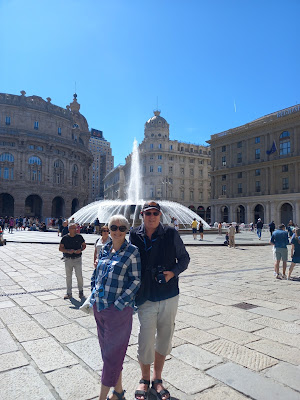Genova is a port city, again with a long pedigree – it’s one of the longest continuously inhabited cities in the world, going back to the 5th millennium BC. It was an equal ally of Rome during the Punic Wars, and was subsequently absorbed into the Roman Empire. Between the 11th and 18th centuries it was one of the most powerful maritime powers. All of this is reflected in the buildings and palazzos around the old port.
We’re staying in the Bristol Palace Hotel – a 5-star Art Nouveau establishment on Via XX Septembre in the heart of the old city. Beautifully restored with marble floors, period furniture, and an ellipsoid staircase spanning six floors which allegedly inspired Alfred Hitchcock’s Vertigo. And, unlike our previous hotel in Florence, you can actually see things.
 |
| That staircase, though |
After breakfast we assembled downstairs for a walking tour of Genoa, led by our guide Paula…who was wrapped up to the nines as if expecting a Southerly gale! The sun was shining and, OK, it was a bit brisk at the beginning of our walk, but really? Anyway, she took us on a medieval walk around the city, pointing out many of the things that we’d seen yesterday but also looking into the nooks and crannies, showing us Christopher Columbus’ house, churches and palazzi, some long-established shops, and ending at the Teatro Carlo Felice Opera House. She also explained why there were so many George crosses decorating the place - apparently it belonged to Genoa long before Richard I appropriated it.
 |
| Christopher Columbus woz ere |
 |
| Whose flag is it anyway? |
 |
| The big church |
 |
| Inside the big church |
 |
| A secret garden |
At the Opera House she handed us over to Anna, who gave us a
tour and talk including a glimpse of the backstage area – usually completely
off-limits to the public. The original 19th century opera house was
damaged by Allied bombing during WW2, and whilst it was repaired several times,
ultimately they decided that this was unsustainable in the long run, bowled it
completely, and rebuilt it in a more modern style. The new opera house reopened
in 1991 and has many design features such as three interchangeable stages which
allow very elaborate production design. We’ll see how that pans out tonight.
There was a further visit available for the Palazzo Rosso, but we decided to skip that in favour of lunch. We’d been advised by Kelly that there was a square a little further down Via XX Septembre that had lots of little eateries in it. We headed down there and found that whilst technically true, what she was describing was essentially the Italian version of Lambton Square: many of the eateries were of other nationalities’ cuisines, and it was a communal eating area. Not quite what we were after, so we wandered a little further along, down one of the streets leading off the main drag, and found ourselves a nice little café called Don'Cola, with an outdoor seating area where we were able to get a decent lunch of gnocchi, spada with pistachio crust, and salad; all washed down with local wine and beer.
 |
| Lambton Square Eatery |
After lunch we took the ascensore up to a higher level of the city for the views out over the city and towards the harbour.
In the evening we headed down to the hotel bar for cocktails, before making the three minute walk around the corner to the Opera House for their production of La Bohème.


No comments:
Post a Comment